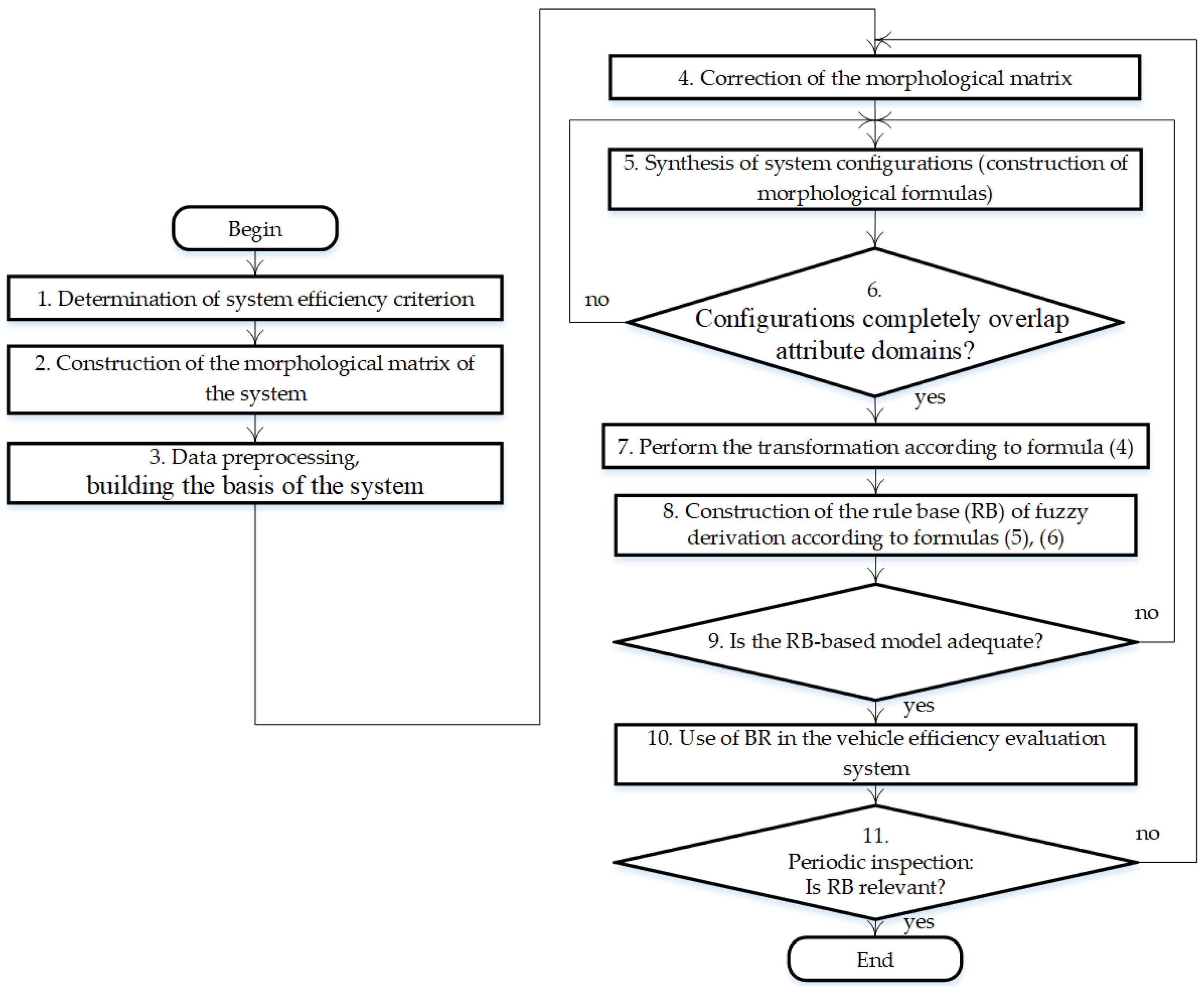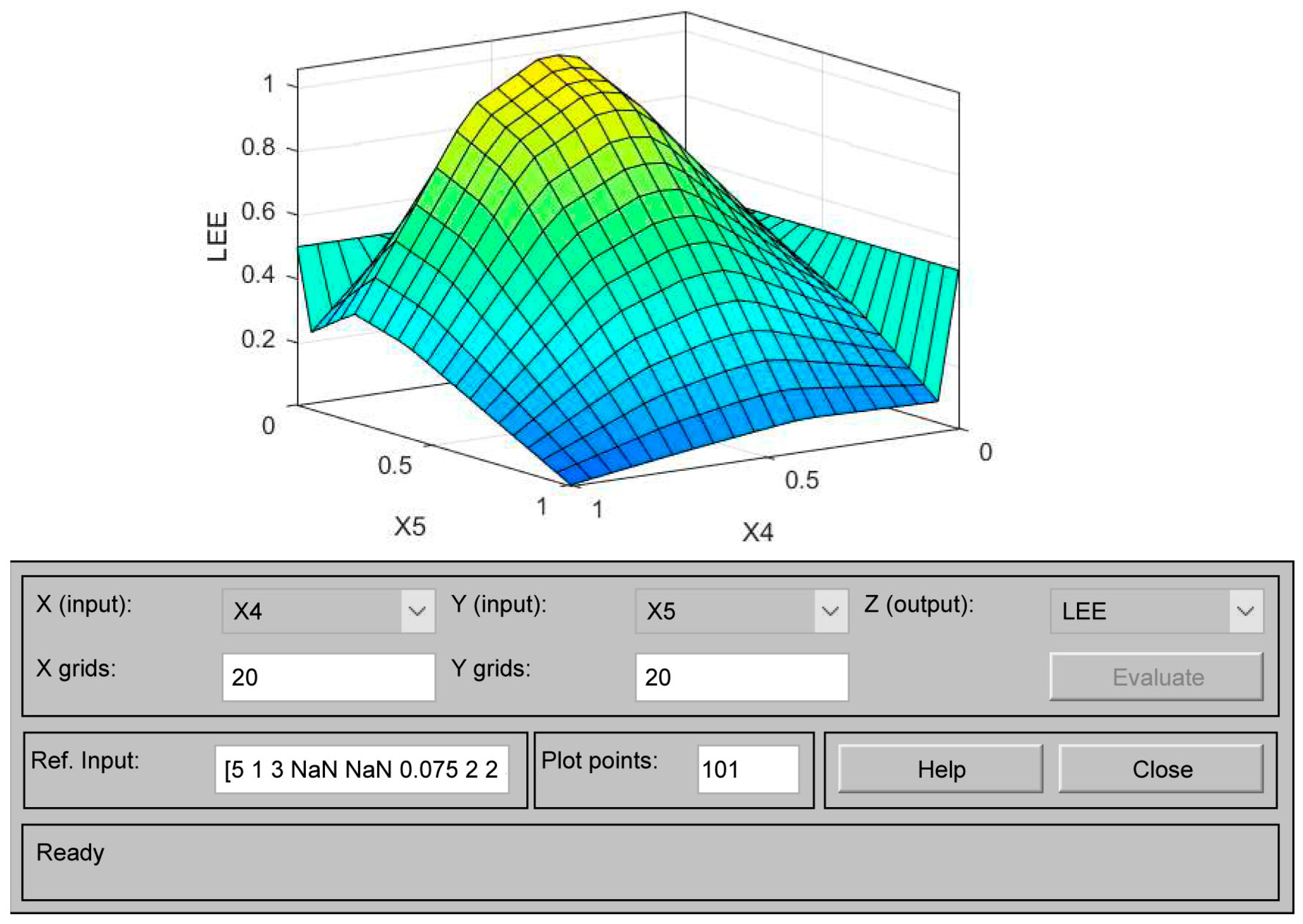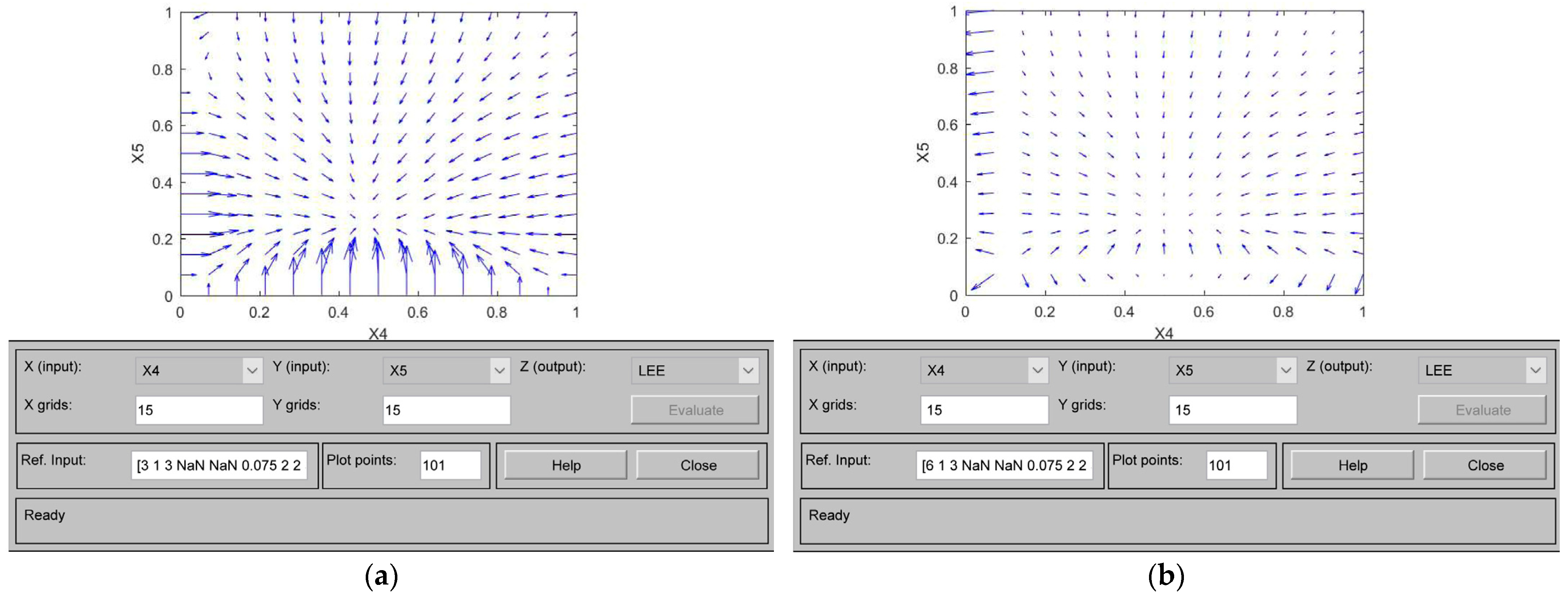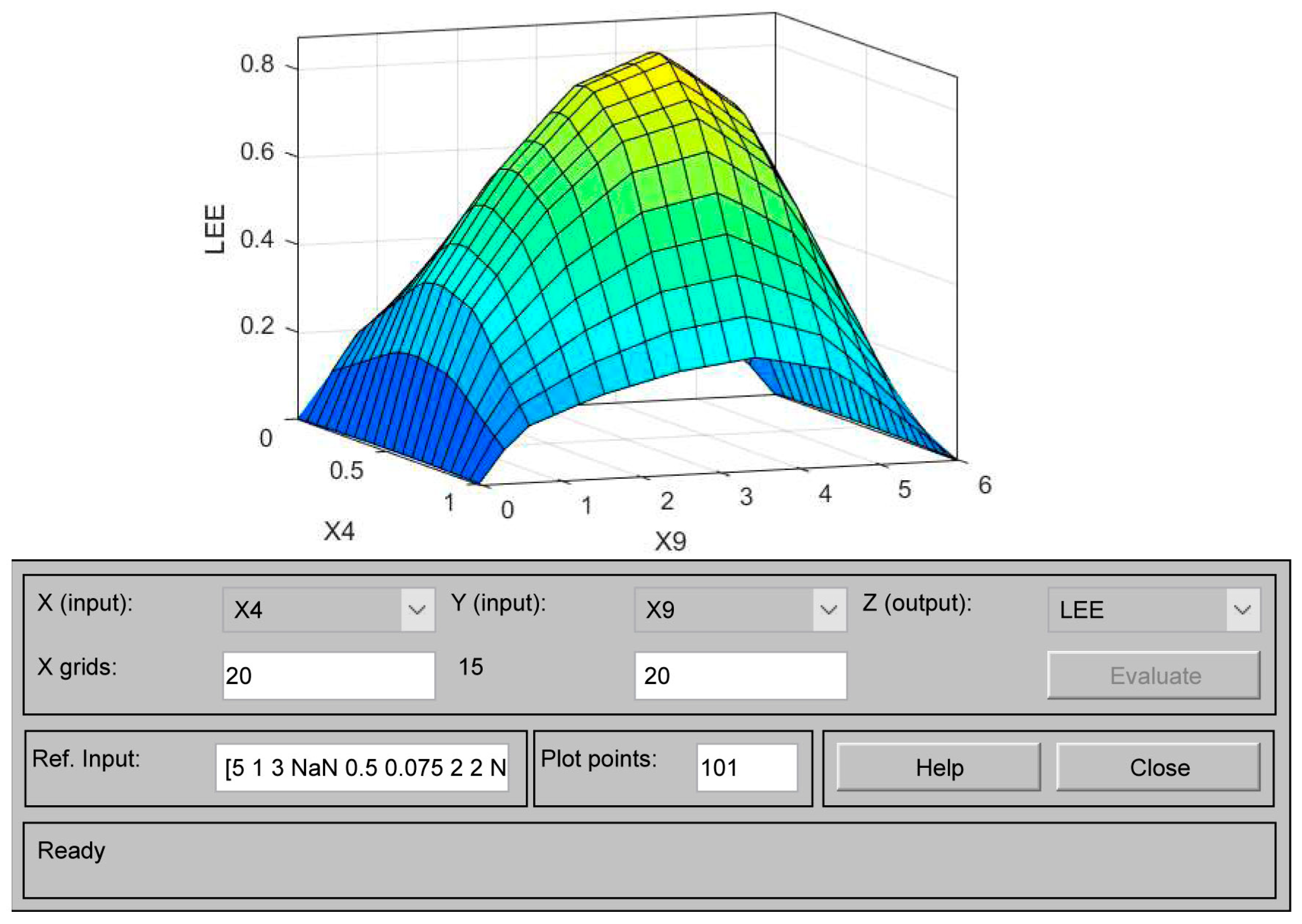Evaluating Vehicle Energy Efficiency in Urban Transport Systems Based on Fuzzy Logic Models
Abstract
1. Introduction
- Formalize the mechanism of synthesis of transport system configurations;
- Synthesize various system configurations based on experimental data;
- Build a fuzzy inference model for evaluating the energy efficiency of the vehicle within the system;
- Determine rational modes of operation of the transport system.
- The Section 1 provides a description of the results of the latest publications on the subject of the research and defines its purpose;
- In the Section 2, the morphological structure of the urban transport system with independent parameters is developed; its morphological model was built in the form of a morphological matrix; the criterion for evaluating the effectiveness of the vehicle is defined; a formalized transition from a morphological system model to a mathematical one is proposed;
- In the Section 3, the experimental part of the research is described, and its partial results are highlighted: the configurations of the transport system are synthesized, and the system of fuzzy rules of derivation is built for the evaluation of the energy efficiency of the vehicle under the given conditions of the transport system; the influence of the system parameters on the energy efficiency of the vehicle was investigated;
- The Section 4 presents the discussion and interpretation of the obtained results;
- The Section 5 summarizes the obtained results and outlines the vector of further research.
2. Materials and Methods
3. Results
3.1. Synthesis of System Configurations
3.2. Construction of TrEECS Nonlinear Models
- Very low (mf1)—from 0 to 0.2;
- Low (mf2)—from 0.21 to 0.4;
- Middle (mf3)—from 0.41 to 0.6;
- High (mf4)—from 0.61 to 0.8;
- Very high (mf5)—from 0.81 to 1.
3.3. The Influence of TrEECS Parameters on the Vehicle Energy Efficiency
4. Discussion
5. Conclusions
Author Contributions
Funding
Data Availability Statement
Conflicts of Interest
References
- Tarandushka, L.; Mateichyk, V.; Kostian, N.; Tarandushka, I.; Rud, M. Assessing the quality level of technological processes at car service enterprises. East.-Eur. J. Enterp. Technol. 2020, 2/3, 58–75. [Google Scholar] [CrossRef]
- Zinko, R.V. Morphological Environment for the Study of Technical Systems: A Monograph; Vydavnytstvo lvivskoi politekhniky: Lviv, Ukraine, 2014; p. 386. ISSN 978-617-607-638-4. [Google Scholar]
- Al-Jazaeri, A.O.; Samaranayake, L.; Longo, S.; Auger, D.J. Fuzzy Logic Control for Energy Saving in Autonomous Electric Vehicles. In Proceedings of the 2014 IEEE International Electric Vehicle Conference, Florence, Italy, 17–19 September 2015. [Google Scholar] [CrossRef]
- Barreno, F.; Santos, M.; Romana, M. Fuzzy Logic System for Risk and Energy Efficiency Estimation of Driving Maneuvers. In 14th International Conference on Computational Intelligence in Security for Information Systems and 12th International Conference on European Transnational Educational (CISIS 2021 and ICEUTE 2021); Springer: Cham, Switzerland, 2021; pp. 94–104. [Google Scholar] [CrossRef]
- Barreno, F.; Santos, M.; Romana, M.G. Fuzzy-Logic Based Identification of Conventional Two-Lane Roads. In 15th International Conference on Soft Computing Models in Industrial and Environmental Applications (SOCO 2020) (SOCO); Springer: Cham, Switzerland, 2020; pp. 418–428. [Google Scholar] [CrossRef]
- Pinilla, A.C.C.; Quintero, M.C.G.; Premachandra, C. Intelligent driving diagnosis based on a fuzzy logic approach in a real environment implementation. In Proceedings of the 2014 IEEE Intelligent Vehicles Symposium Proceedings, Dearborn, MI, USA, 8–11 June 2014; pp. 102–107. [Google Scholar] [CrossRef]
- Abulifa, A.A.; Che Soh, A.; Hassan, M.K.; Raja Ahmad, R.M.K.; Mohd Radzi, M.A. Energy Management System in Battery Electric Vehicle Based on Fuzzy Logic Control to Optimize the Energy Consumption in HVAC System. Int. J. Integr. Eng. 2019, 11, 11–20. [Google Scholar] [CrossRef]
- Yang, L.; Wang, Y.; Zhu, C. Study on Fuzzy Energy Management Strategy of Parallel Hybrid Vehicle Based on Quantum PSO Algorithm. Int. J. Multimed. Ubiquitous Eng. 2016, 11, 147–158. [Google Scholar] [CrossRef]
- Mohd, T.A.T.; Hassan, M.K.; Aris, I.; Azura, C.S.; Ibrahim, B.S.K.K. Application of fuzzy logic in multi-mode driving for a battery electric vehicle energy management. Int. J. Adv. Sci. Eng. Inf. Technol. 2017, 7, 284–290. [Google Scholar] [CrossRef]
- Brzozowski, K.; Ryguła, A.; Maczyński, A. An Integrated System for Simultaneous Monitoring of Traffic and Pollution Concentration—Lessons Learned for Bielsko-Biała, Poland. Energies 2021, 14, 8028. [Google Scholar] [CrossRef]
- Olayode, I.O.; Severino, A.; Tartibu, L.K.; Arena, F.; Cakici, Z. Performance Evaluation of a Hybrid PSO Enhanced ANFIS Model in Prediction of Traffic Flow of Vehicles on Freeways: Traffic Data Evidence from South Africa. Infrastructures 2022, 7, 2. [Google Scholar] [CrossRef]
- Zajačko, I.; Gál, T.; Ságová, Z.; Mateichyk, V.; Wiecek, D. Application of artificial intelligence principles in mechanical engineering. MATEC Web Conf. Innov. Technol. Eng. Prod. (ITEP’18) 2018, 244, 01027. [Google Scholar] [CrossRef]
- Lim, J.; Lee, Y.; Kim, K.; Lee, J. Experimental Analysis of Calculation of Fuel Consumption Rate by On-Road Mileage in a 2.0 L Gasoline-Fueled Passenger Vehicle. Appl. Sci. 2018, 8, 2390. [Google Scholar] [CrossRef]
- Khabutdinov, R.A.; Fedorenko, I.O. Analysis of the impact of transport energy efficiency indicators of the bus for urban passenger transportation. Sci. Notes V.I. Vernadsky Taurida Natl. Univ. Ser. Tech. Sci. 2021, 32, 259–266. (In Ukrainian) [Google Scholar] [CrossRef]
- Śmieszek, M.; Mateichyk, V. Determining the fuel consumption of a public city bus in urban traffic. In IOP Conference Series: Materials Science and Engineering, Proceedings of the 26th International Slovak-Polish Scientific Conference on Machine Modelling and Simulations (MMS 2021), Bardejovské Kúpele, Slovak Republic, 13–15 September 2021; IOP Publishing Ltd.: Bristol, UK, 2021; Volume 1199. [Google Scholar] [CrossRef]
- Dmytriiev, M.M. M 218-02070915-694:2011 Methods for Assessing the Ingredient and Parametric Pollution of the Roadside Environment by the System Traffic Flow—Road; National Transport University: Kyiv, Ukraine, 2011; p. 28. [Google Scholar]
- Ahn, K.; Rakha, H.; Trani, A.; Van Aerde, M. Estimating vehicle fuel consumption and emissions based on instantaneous speed and acceleration levels. J. Transp. Eng. 2002, 128, 182–190. [Google Scholar] [CrossRef]
- Du, J.; Rakha, H.A.; Filali, F.; Eldardiry, H. COVID-19 pandemic impacts on traffic system delay, fuel consumption and emissions. Int. J. Transp. Sci. Technol. 2021, 10, 184–196. [Google Scholar] [CrossRef]
- Lahlou, A.; Ossart, F.; Boudard, E.; Roy, F.; Bakhouya, M. A Real-Time Approach for Thermal Comfort Management in Electric Vehicles. Energies 2020, 13, 4006. [Google Scholar] [CrossRef]
- Patrone, G.L.; Paffumi, E.; Otura, M.; Centurelli, M.; Ferrarese, C.; Jahn, S.; Brenner, A.; Thieringer, B.; Braun, D.; Hoffmann, T. Assessing the Energy Consumption and Driving Range of the QUIET Project Demonstrator Vehicle. Energies 2022, 15, 1290. [Google Scholar] [CrossRef]
- Klimenko, A.; Hill, N.; Windisch, E. Approaches to regulation of CO2 emission and energy consumption indicators of new light duty vehicles in Ukraine. Bull. Natl. Transp. Univ. 2019, 1, 66–75. (In Ukrainian) [Google Scholar] [CrossRef]
- Khabutdinov, R.A. System concept of energy-resource synergy and methodology of technological-innovative management on motor transport. Bull. Natl. Transp. Univ. 2020, 1, 365–374. (In Ukrainian) [Google Scholar] [CrossRef]
- Kosai, S.; Nakanishi, M.; Yamasue, E. Vehicle energy efficiency evaluation from well-to-wheel lifecycle perspective. Transp. Res. Part D Transp. Environ. 2018, 65, 355–367. [Google Scholar] [CrossRef]
- Synák, F.; Kučera, M.; Skrúcaný, T. Assessing the Energy Efficiency of an Electric Car. Communications 2021, 23, 1–13. [Google Scholar] [CrossRef]
- Podrigalo, M.A.; Abramov, D.V.; Tarasov, Y.V.; Kholodov, M.P.; Kaidalov, R.O.; Podrigalo, N.M.; Shein, V.S. Improvement evaluation methodology of vehicle load and energy efficiency. Automob. Transp. 2021, 49, 36–44. [Google Scholar] [CrossRef]
- Weiss, M.; Cloos, K.C.; Helmers, E. Energy efficiency trade-offs in small to large electric vehicles. Environ. Sci. Eur. [Online] 2020, 32, 46. [Google Scholar] [CrossRef]
- Mohanadass, A. Making the Most of the Energy We Have: Vehicle Efficiency. In Advanced Energy Management, Modelling and Control for Intelligent and Efficient Transport Systems - Design, Modelling, Control and Simulation; Truong Quang Dinh; IntechOpen: Coventry, UK, 2020; pp. 1–19. [Google Scholar] [CrossRef]
- Smieszek, M.; Kostian, N.; Mateichyk, V.; Mościszewski, J.; Tarandushka, L. Determination of the Model Basis for Assessing the Vehicle Energy Efficiency in Urban Traffic. Energies 2021, 14, 8538. [Google Scholar] [CrossRef]
- Snytiuk, V.Y. Prognostication. Models. Methods. Algorithms; Maklaut: Kyiv, Ukraine, 2008; p. 364. [Google Scholar]







| Methods and Technologies | Reference Number | Advantages | Disadvantages |
|---|---|---|---|
| Morphological analysis method | [1] | The principle of constructing a morphological matrix and morphological formulas is described | The transition to an equivalent mathematical model has not been formalized |
| [2] | The stages of morphological analysis are described | The presented models only take into account the operational characteristics and design of the vehicle | |
| Soft Computing Technologies (fuzzy logic) | [3] | A model for forecasting energy efficiency was built | The model is only adequate for electric vehicles |
| [4] | The developed intelligent system ensures an increase in the efficiency of transport processes | Traffic environment parameters, weather conditions and hours of the day are not taken into account | |
| [5] | The results can be used to define the attributes of the element of the “Road” system | Only Two-Lane Roads are considered | |
| [6] | Real driving conditions are considered; traffic rules are taken into account | An intelligent system is not universal; the energy efficiency of the vehicle is not taken into account | |
| [7,8,9] | An intelligent system for controlling the energy consumption of vehicles has been developed, which allows to increase energy efficiency up to 20.4% | Only the vehicle parameters are taken into account (weather conditions are also taken into account in [8]); the system is intended for only one model of electric vehicle/hybrid vehicle; there is no argumentation for choosing the defuzzification method | |
| Soft Computing Technologies (neural network) | [10,11] | Attributes of the functional element of the “Transport flow” system are defined; in [11] an adaptive fuzzy neural network is used | In [10], the training sample is only a third of the initial sample; the modeling error (Mean Absolute Percentage Error) is significant and amounts to 24%. In [11], not all categories of vehicles were taken into account |
| [12] | Used deep convolutional neural networks ensured an increase in the productivity of the machine learning system; the method can be used to determine the structure of the traffic flow | It requires significant financial resources to identify traffic flows on the entire street network of the city | |
| Analytical and statistical methods of energy efficiency assessment | [13] | The indicator of energy efficiency of the vehicle was determined | The indicator does not take into account vehicle loading, environmental, traffic flow, roads parameters |
| [14,15] | The indicator of energy efficiency of the vehicle was determined | Research is limited to a given class of bus | |
| [16,17,18] | Analytical estimates of the fuel consumption of arbitrary vehicle have been developed | The parameters of other (except vehicle) functional elements of the transport system are not taken into account | |
| [19,20] | models were built to forecast the energy required for efficient HVAC operation; the parameters of all functional elements of the system are taken into account | The average relative error can reach 10%; models are only adequate for electric vehicles | |
| [21] | Own unique vehicle test procedures for tracking fuel consumption have been developed | Dependence of the complexity of formalization of system parameters on their number | |
| [22,23] | Comprehensive indicators of energy efficiency of various categories of vehicles, taking into account their construction and road parameters, are proposed | Requires additional calculations in accordance with the specifics of various vehicles and types of test operations; in [23], the use of the indicator requires annual sales statistics | |
| [24,25,26] | Analytical dependencies of energy efficiency indicators were obtained; a comparison of the energy efficiency of different categories of electric vehicles was made | The energy efficiency of only electric cars was studied | |
| [27] | The types of energy losses in vehicles and methods of their elimination are systematized | Only the parameters of the “vehicle” functional element are taken into account |
| Vehicle | Traffic Flow | Road | Traffic Environment | ||||||
|---|---|---|---|---|---|---|---|---|---|
| 1. Category | 2. Energy Unit Type | 3. Vehicle Age | 4. The Degree of Use of Load/Passenger Capacity | 5. Traffic Flow Complexity Level | 6. Road Resistance Degree, f + i | 7. Carriageway Curvature Degree | 8. Level of Motorization, Cars/1000 Inhabitants | 9. Time Interval | 10. Complexity of Weather Conditions |
| 1.1. M1 1 | 2.1. Petrol 1 | 3.1. Up to 5 years 1 | 4.1. Low 0–0.4 | 5.1. Low 0–0.2 | 6.1. Low 0.007–0.049 | 7.1. Low 2maxR/3-maxR 1 | 8.1. Low <200 1 | 9.1. Rush hours 1 | 10.1. Low 0–0.19 |
| 1.2. M2 2 | 2.2. Diesel 2 | 3.2. 5–10 years 2 | 4.2. Medium 0.41–0.5 | 5.2. Medium 0.21–0.4 | 9.2. Hours of increasing traffic intensity 2 | 10.2. Medium 0.2–0.39 | |||
| 1.3. M3 3 | 2.3. Gas 3 | 3.3. 10–15 years 3 | 4.3. High 0.51–0.7 | 5.3. High 0.41–0.7 | 6.2. Medium 0.05–0.099 | 7.2. Medium maxR/3–2maxR/3 2 | 8.2. Medium 200–300 2 | 9.3. Hours of steady traffic intensity 3 | 10.3. High 0.4–0.69 |
| 1.4. N1 4 | 3.4. 15–20 years 4 | ||||||||
| 1.5. N2 5 | 2.4. Hybrid and electric 4 | 3.5. More than 20 years 5 | 4.4. Very high 0.71–1 | 5.4. Very high 0.71–1 | 6.3. High 0.1–0.15 | 7.3. High 0-maxR/3 3 | 8.3. High > 300 3 | 9.4. Hours of decreasing traffic intensity 4 | 10.4. Very high 0.7–1 |
| 1.6. N3 6 | 9.5. Night hours 5 | ||||||||
| Inputs | Membership Function mf Parameters | Inputs/ Output | Membership Function mf Parameters | ||||||||
|---|---|---|---|---|---|---|---|---|---|---|---|
| a | b | c | d | a | b | c | d | ||||
| X1 | 0 | 0.5 | 1.5 | 7 | X6 | 0 | 0.007 | 0.049 | 0.151 | ||
| 0 | 1.5 | 2.5 | 7 | 0 | 0.05 | 0.099 | 0.151 | ||||
| 0 | 2.5 | 3.5 | 7 | 0 | 0.1 | 0.15 | 0.151 | ||||
| 0 | 3.5 | 4.5 | 7 | X7 | 0 | 0.5 | 1.5 | 4 | |||
| 0 | 4.5 | 5.5 | 7 | 0 | 1.5 | 2.5 | 4 | ||||
| 0 | 5.5 | 6.5 | 7 | 0 | 2.5 | 3.5 | 4 | ||||
| X2 | 0 | 0.5 | 1.5 | 5 | X8 | 0 | 0.5 | 1.5 | 4 | ||
| 0 | 1.5 | 2.5 | 5 | 0 | 1.5 | 2.5 | 4 | ||||
| 0 | 2.5 | 3.5 | 5 | 0 | 2.5 | 3.5 | 4 | ||||
| 0 | 3.5 | 4.5 | 5 | X9 | 0 | 0.5 | 1.5 | 6 | |||
| X3 | 0 | 0.5 | 1.5 | 6 | 0 | 1.5 | 2.5 | 6 | |||
| 0 | 1.5 | 2.5 | 6 | 0 | 2.5 | 3.5 | 6 | ||||
| 0 | 2.5 | 3.5 | 6 | 0 | 3.5 | 4.5 | 6 | ||||
| 0 | 3.5 | 4.5 | 6 | 0 | 4.5 | 5.5 | 6 | ||||
| 0 | 4.5 | 5.5 | 6 | X10 | 0 | 0.05 | 0.19 | 1.01 | |||
| X4 | 0 | 0.01 | 0.4 | 1.01 | 0 | 0.2 | 0.39 | 1.01 | |||
| 0 | 0.41 | 0.5 | 1.01 | 0 | 0.4 | 0.69 | 1.01 | ||||
| 0 | 0.51 | 0.7 | 1.01 | 0 | 0.7 | 1 | 1.01 | ||||
| 0 | 0.71 | 1 | 1.01 | LEE | 0 | 0.01 | 0.2 | 1.01 | |||
| X5 | 0 | 0.01 | 0.2 | 1.01 | 0 | 0.21 | 0.4 | 1.01 | |||
| 0 | 0.21 | 0.4 | 1.01 | 0 | 0.41 | 0.6 | 1.01 | ||||
| 0 | 0.41 | 0.7 | 1.01 | 0 | 0.61 | 0.8 | 1.01 | ||||
| 0 | 0.71 | 1 | 1.01 | 0 | 0.81 | 1 | 1.01 | ||||
| Configuration Number | Left Part of the Morphological Formula | LEEtabl | Sample Type |
|---|---|---|---|
| 1 | 0.648 | training | |
| 2 | 0.632 | training | |
| 3 | 0.556 | training | |
| 4 | 0.227 | control | |
| 5 | 0.632 | control | |
| 6 | 0.060 | training | |
| 7 | 0.681 | training | |
| 8 | 0.958 | training | |
| 9 | 0.859 | training | |
| 10 | 0.329 | control | |
| 11 | 0.017 | training | |
| 12 | 0.601 | training | |
| 13 | 0.430 | training | |
| 14 | 0.556 | training | |
| 15 | 0.175 | training | |
| 16 | 0.802 | training | |
| 17 | 0.632 | training | |
| 18 | 0.859 | training | |
| 19 | 0.897 | training | |
| 20 | 0.366 | control | |
| 21 | 0.145 | control | |
| 22 | 0.681 | training | |
| 23 | 0.714 | training | |
| 24 | 0.271 | training | |
| 25 | 0.329 | training |
| Configuration Number | Control Output Value LEE | Defuzzification Methods | |||||
|---|---|---|---|---|---|---|---|
| Mamdani Type Model | Sugeno-Model | ||||||
| Bisector | Centroid | The Smallest of Maximums | The Mean of Maximums | The Weighted Average | The Weighted Sum | ||
| Model Output Value LEEmodel | |||||||
| 4 | 0.568 | 0.668 | 0.665 | 0.623 | 0.691 | 0.691 | 0.727 |
| 5 | 0.690 | 0.659 | 0.658 | 0.584 | 0.692 | 0.688 | 0.706 |
| 10 | 0.599 | 0.635 | 0.640 | 0.509 | 0.586 | 0.650 | 0.682 |
| 20 | 0.610 | 0.656 | 0.654 | 0.623 | 0.691 | 0.643 | 0.768 |
| 21 | 0.543 | 0.650 | 0.651 | 0.506 | 0.641 | 0.650 | 0.604 |
| Average value | 0.60197 | 0.6536 | 0.65354 | 0.569 | 0.6599 | 0.66446 | 0.69722 |
| Standard deviation σ | |||||||
| 4 | 0.009964 | 0.009374 | 0.003005 | 0.014962 | 0.015183 | 0.02535 | |
| 5 | 0.000940 | 0.001034 | 0.011163 | 0.000005 | 0.000005 | 0.000251 | |
| 10 | 0.001310 | 0.001705 | 0.008064 | 0.000177 | 0.002591 | 0.006839 | |
| 20 | 0.002138 | 0.001975 | 0.000175 | 0.006520 | 0.001132 | 0.024915 | |
| 21 | 0.011347 | 0.011539 | 0.001405 | 0.009510 | 0.011411 | 0.003675 | |
| Average value | 0.00514 | 0.005126 | 0.004763 | 0.006235 | 0.006064 | 0.012206 | |
| Relative standard deviation Sr | |||||||
| 4 | 0.03086 | 0.02904 | 0.00931 | 0.04635 | 0.04703 | 0.07853 | |
| 5 | 0.00198 | 0.00217 | 0.02347 | 0.00001 | 0.00001 | 0.00053 | |
| 10 | 0.00365 | 0.00476 | 0.02249 | 0.00049 | 0.00722 | 0.01907 | |
| 20 | 0.00575 | 0.00531 | 0.00047 | 0.01754 | 0.00304 | 0.06701 | |
| 21 | 0.03842 | 0.03907 | 0.00476 | 0.03220 | 0.03863 | 0.01244 | |
| Average value | 0.016132 | 0.016069 | 0.012099 | 0.019317 | 0.019188 | 0.035516 | |
Disclaimer/Publisher’s Note: The statements, opinions and data contained in all publications are solely those of the individual author(s) and contributor(s) and not of MDPI and/or the editor(s). MDPI and/or the editor(s) disclaim responsibility for any injury to people or property resulting from any ideas, methods, instructions or products referred to in the content. |
© 2023 by the authors. Licensee MDPI, Basel, Switzerland. This article is an open access article distributed under the terms and conditions of the Creative Commons Attribution (CC BY) license (https://creativecommons.org/licenses/by/4.0/).
Share and Cite
Mateichyk, V.; Kostian, N.; Smieszek, M.; Mosciszewski, J.; Tarandushka, L. Evaluating Vehicle Energy Efficiency in Urban Transport Systems Based on Fuzzy Logic Models. Energies 2023, 16, 734. https://doi.org/10.3390/en16020734
Mateichyk V, Kostian N, Smieszek M, Mosciszewski J, Tarandushka L. Evaluating Vehicle Energy Efficiency in Urban Transport Systems Based on Fuzzy Logic Models. Energies. 2023; 16(2):734. https://doi.org/10.3390/en16020734
Chicago/Turabian StyleMateichyk, Vasyl, Nataliia Kostian, Miroslaw Smieszek, Jakub Mosciszewski, and Liudmyla Tarandushka. 2023. "Evaluating Vehicle Energy Efficiency in Urban Transport Systems Based on Fuzzy Logic Models" Energies 16, no. 2: 734. https://doi.org/10.3390/en16020734
APA StyleMateichyk, V., Kostian, N., Smieszek, M., Mosciszewski, J., & Tarandushka, L. (2023). Evaluating Vehicle Energy Efficiency in Urban Transport Systems Based on Fuzzy Logic Models. Energies, 16(2), 734. https://doi.org/10.3390/en16020734










